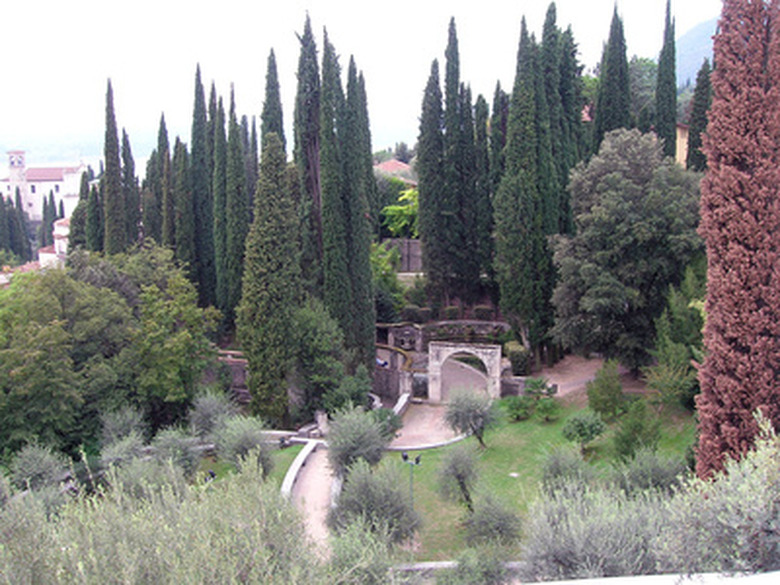The Meaning Behind Cypress Trees
There's something magical about a conifer. Long after the development of botany as a science that explains why some trees shed their leaves each fall and some remain evergreen, we bring pines and spruces indoors at year end to symbolize light and new birth. The cypress, native to the area where civilization began, has its own history of meaning and symbolism.
Identification
Cupressus sempervirens, the Mediterranean or Italian cypress, is a native conifer of the Eastern Mediterranean, the cradle of Western civilization. It grows 20 to 30 feet tall, with aromatic wood and scaled leaves. Cypresses are long-lived trees; according to Iranian legend, the cypress tree of Kashmar, planted by Zoroaster, lived 1,405 years, according to Rozaneh Magazine. In the United States the Italian cypress is hardy from USDA zone seven to zone nine.
- There's something magical about a conifer.
- Cupressus sempervirens, the Mediterranean or Italian cypress, is a native conifer of the Eastern Mediterranean, the cradle of Western civilization.
Significance
Although the cypress family contains other cultivars, the Mediterranean cypress is a tree that was present where Western literature and religion began; it appears in the "Shahnameh," a Persian epic by Ferdowsi (940-1020). Amots Dafni, Efraim Lev, Sabine Beckmann, and Christian Eichberger, in "Ritual Plants of Muslim Graveyards in Northern Israel," report that the cypress was planted around graveyards as a representation of both death and the immortality of the soul.
Evolution
A summary of the significance of conifers in human culture published by the U.N. Food and Agriculture Organization (FAOUN) lists several legends and associations that helped establish the cypress as a dualistic representative of death and immortality. A dying Adam begged his son to bring oil from Tree of Life in the Garden of Eden to him; the boy was too late but planted a slip on Adam's grave where a tree grew with branches of cypress, cedar and olive. These three woods made up the cross upon which Christ would die. In Ovid's "Metamorphosis," a youth named Kyparissos dies and is transformed into a cypress tree.
Middle Ages
During the European Middle Ages, legends and myths evolved as cultures changed; through its association with Adam and Jesus, the cypress tree became a potent Christian symbol. FAOUN reports that the entry doors of St. Peter's basilica were originally carved of cypress. During the Middle Ages, years of plague and instability, the subtle dual symbolism of death and resurrection simplified into the more concrete concept of death.
- Although the cypress family contains other cultivars, the Mediterranean cypress is a tree that was present where Western literature and religion began; it appears in the "Shahnameh," a Persian epic by Ferdowsi (940-1020).
- Amots Dafni, Efraim Lev, Sabine Beckmann, and Christian Eichberger, in "Ritual Plants of Muslim Graveyards in Northern Israel," report that the cypress was planted around graveyards as a representation of both death and the immortality of the soul.
Art and the Cypress
Renaissance artists used symbolic objects to communicate with an audience that was largely illiterate. Later, during the Victorian era, the cypress with its dark branches and tall columnar shape was a symbol of the cemetery and death and was widely planted in European as well as Middle Eastern graveyards. The 19th century artist Van Gogh may have preserved the symbolism in a painting that he completed during his stay in the south of France in 1890; the cypress tree occupies a central position in the famous "Road with Cypress and Star," reaching from earth to the heavens.
References
- Rozaneh Magazine: The Cypress of Zoroaster
- Pub Med Journal of Ethnobiology and Ethhnomedicine: Ritual Plants of Muslim graveyards in Northern Israel
- Food and Agriculture Organization of the United Nations:Conifers in Human Culture
- Medieval Life and Times: Meaning of Trees in Christian Art
- Princeton University Art: Van Gogh's Grapple with Death
